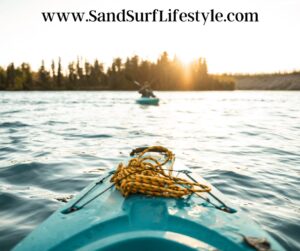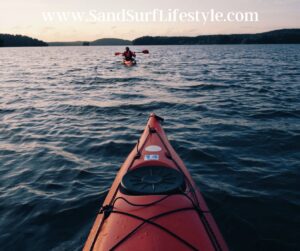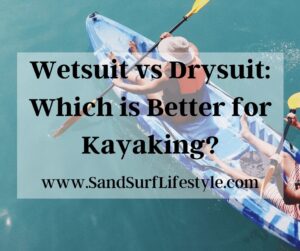Wetsuit vs drysuit: Which is better for kayaking?
If you’re wondering whether a wetsuit or drysuit is better for kayaking, you’re not alone. Here’s the thing: wetsuits and drysuits are both extremely viable options for kayaking. Nevertheless, there are vital distinctions between the two that can’t be ignored when deciding which to wear out on the water.
What determines whether a wetsuit or drysuit is better for kayaking primarily comes down to one simple factor: water temperature. Since water immersion is almost a given when it comes to kayaking, wetsuits of varying coverage are appropriate for warmer water temperatures, whereas well-layered drysuits are better for colder ones.
Why Water Temperature Matters
Now, you might be wondering — if you’re out paddling on a kayak, why should water temperature even matter? Shouldn’t air temperature matter more when you’re above the surface?
 Well, the answer is yes — and no. Air temperature is very important to take into consideration while selecting your kayaking gear, but it’s actually water temperature that accounts for most boating-related deaths. That’s why one of the biggest and gravest mistakes people make while kayaking is dressing for the air temperatures alone.
Well, the answer is yes — and no. Air temperature is very important to take into consideration while selecting your kayaking gear, but it’s actually water temperature that accounts for most boating-related deaths. That’s why one of the biggest and gravest mistakes people make while kayaking is dressing for the air temperatures alone.
When dressing to kayak, one should always be prepared for the likelihood of immersion in the water and, therefore, the water’s corresponding temperature. As any water sports enthusiast will tell you, being submerged in cold water is an extremely different experience from being surrounded by cold air.
Many boating deaths result from paddlers’ lack of preparation for potential cold-water immersion. Water 50 degrees Fahrenheit, or 10 degrees Celsius, and under is notoriously dangerous — especially for those unprepared for the cold. These are the temperatures at which most cold-water boating deaths occur.
Still, around one-third of temperature-related boating deaths occur at water temperatures between 50 and 68 degrees Fahrenheit, or 10 and 20 degrees Celsius. Even with proximity to the boat, a dock, or dry land, many people still don’t survive the grave effects of cold water.
You can be the best swimmer or paddler, but anyone who has kayaked regularly can tell you that falling overboard or having the boat capsize are still both extremely common and inevitable occurrences. Moreover, once you’re immersed in cold water, it often doesn’t matter if you can swim or not. Unbearable water temperatures are unbearable water temperatures, capable of rendering the body frozen and unusable mere moments after impact.
That’s why it’s so vital paddlers dress appropriately for kayaking — because doing so can mean the difference between dying a cold, painful death and enjoying a nice, post-boating cup of hot cocoa by the fire.
Let’s start with the basics.
Layering
You might be wondering about layering, or even why what type of gear you wear makes a difference. Conversely, you might be asking why we’re discussing layering first before getting into the differences between wetsuits and drysuits. Well, the reason for this is because a proper understanding of layering is crucial for anyone preparing to go out on the water — regardless of whether you opt for a wetsuit or a drysuit.
There are situations where a wetsuit might not need to be layered. However, a drysuit is always an outer layer, and therefore, is not intended to be worn alone.
There are three main categories of layers that all paddlers should know and keep handy.
The first is the base layer — the one closest to the skin. This layer is generally wool or synthetic and serves the purpose of absorbing sweat from your body in order to keep you dry. One example of a base layer is thermal wear. Base layers are only applicable to drysuits, since wetsuits function best against bare skin.
The second is the mid-layer. This is generally a warm piece of clothing (or multiple, depending on the conditions) that won’t trap water in its fabric. Fleece comes among the most recommended materials for mid-layer wear.
The third (and last) is the outer layer. This layer’s purpose is to prevent wind and water from infiltrating the other ones. Paddling jackets, drytops, and drysuits are all examples of outer layer wear.
On this note, keep in mind that a drysuit only works so far as the appropriate layers are worn for the temperatures at hand. We’ll get into this in more detail in just a moment.
Do sharks attack kayaks? Find out here.
The Differences Between a Wetsuit and a Drysuit

Wetsuits and drysuits utilize different materials for varying purposes.
Wetsuits have neoprene, which serves to absorb small amounts of water and hold them close to your body. Now, this might sound counterproductive, but we promise you — it makes complete sense. You see, having water locked in and kept near your body like this permits your body to warm it up. Therefore, the trapped water, once warm, keeps you warmer than you might’ve been otherwise. This is a natural, aquatic-based form of insulation.
Wetsuits, especially full-body ones, are usually categorized by a numbering system: [#]/[#]. The first number indicates the thickness of the wetsuit’s central region, and the second indicates the thickness of the neoprene in vital areas.
Paddling wetsuits frequently come without arms so that the neoprene doesn’t limit movement while paddling. While fantastic for mobility, these types of suits sacrifice warmth and the ability to wholly keep water out of your suit and away from your skin. That’s why full-body suits, despite the reduced mobility they provide while paddling, are better for colder air and water temperatures.
Regarding price, wetsuits usually range between $100 and $400.
Alternatively, drysuits utilize a variety of gaskets — primarily neck and wrist ones — in addition to waterproof fabric. Together, these serve to entirely guard your body against the water. Unlike the wetsuit, the drysuit doesn’t trap a layer of water for warmth and isn’t warm by itself. Rather, it serves to keep the water out of your suit and away from your body.
For warmth, it’s necessary to wear additional layers underneath, treating the drysuit only as an outer layer. With time, most intermediate and seasoned boaters come to prefer drysuits, finding them to be more comfortable than the alternative.
On average, drysuits tend to cost between $600 and $1,000.
When to Wear Which
For water that is 70 degrees Fahrenheit, or 21 degrees Celsius, and higher, you don’t need a wetsuit or a drysuit — only a rash guard and standard water apparel. Regardless of the lovely weather, be sure to also keep a paddling jacket or drytop available in a waterproof bag. This is important in the event the water gets too cold later on. The exception to this rule is if the air temperature drops below 50 degrees Fahrenheit, or 10 degrees Celsius. Then, despite the warm water temperature, you might want to switch to a wetsuit and throw on some layers.
 For water that is 50 to 70 degrees Fahrenheit, or 10 to 21 degrees Celsius, a wetsuit without arms is recommended. However, for the lower part of that temperature range (and/or lower air temperatures), a full-body wetsuit or lightly layered drysuit might be preferable. Either way, keep a paddling jacket, drytop, and additional layers available to you in a waterproof bag just in case it begins to get too cold. And remember — as the air gets colder, the water generally does, too.
For water that is 50 to 70 degrees Fahrenheit, or 10 to 21 degrees Celsius, a wetsuit without arms is recommended. However, for the lower part of that temperature range (and/or lower air temperatures), a full-body wetsuit or lightly layered drysuit might be preferable. Either way, keep a paddling jacket, drytop, and additional layers available to you in a waterproof bag just in case it begins to get too cold. And remember — as the air gets colder, the water generally does, too.
For water that is 45 to 55 degrees Fahrenheit, or 7 to 13 degrees Celsius, your best bet is wearing either a 4/3 full-body wetsuit or else a decently layered drysuit. Should you opt for the wetsuit, be sure to include some mid-layers and throw an outer layer piece on top. Should you prefer to go with a drysuit, you will still need to wear sufficient base and mid-layers underneath. Once you get down to these temperatures, you’ll also need gear to keep your hands, feet, and head warm. Winter kayaking apparel should do the trick.
Now, for water that is 45 degrees Fahrenheit, or 7 degrees Celsius, and lower, you will officially be dealing with the bitter cold. Therefore, wetsuits, layered or otherwise, are no longer an option. At this point, you’ll need a drysuit with an extremely warm, thick base and mid-layers, as well as winter kayaking gear for your hands, feet, and head.
This isn’t the place to skimp on the layers or accessories you’ll need to keep yourself safe, warm, and dry. Cold shock upon hitting the water is a strong possibility for paddlers who boat on these waters — especially those who come underdressed and, therefore, unprepared. It’s better to be safe than sorry. Layer up.
However, you’ll also want to keep in mind that wearing a drysuit in extremely warm temperatures or sweltering heat will be extremely hot and uncomfortable — sometimes even at your own detriment.
If there’s one thing you take from this article, it should be this: always dress not merely for air temperatures, but for the water ones as well. Water immersion is not simply a possibility while kayaking — it’s an extremely anticipated outcome and known risk of the sport.
When it comes to kayaking, dressing accordingly may very well be the difference between life and death.
Related Questions
Should I wear a lifejacket while kayaking? Yes. Many might tell you it isn’t necessary, but most people who die in the water while kayaking either aren’t wearing a lifejacket or aren’t wearing one correctly. Always take the additional time to ensure you’re wearing yours properly.
Should I dress for air temperatures as well? Absolutely. Always dress for both air and water temperatures, leaning more into the colder of the two. More often than not, water temperatures are colder than air temperatures, but in the event, this isn’t the case, it’s important to be dressed to bear temperatures both above and below the surface effectively.

Please note: This blog post is for educational purposes only and does not constitute legal or medical advice. Please consult a legal expert or medical professional to address your specific needs.

